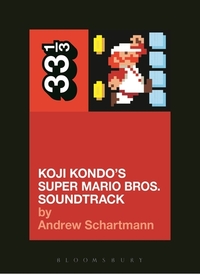Take a photo of a barcode or cover
A fun, short read, into the making of quite possibly the most memorable video game music ever made. Although I would warn potential readers that the authors does go into a lot of music theory. I'm a self-taught musician and I found certain passage hard to follow. There is a lot sheet music examples and talk surrounding chord progressions, etc. This is the main reason I didn't give this book 4 stars. Otherwise the history of video game music, the discussions about the limitations the original NES console had, etc were very interesting.
informative
medium-paced
Concise look at the history and structure of video gamings' arguably most memorable 3 minutes of music, showing the context and limitations in which it came to be and structurally how and why it works well.
I received this from NetGalley in exchange for an honest review.
This is a detailed account about the music of Super Mario Brothers, and although a lot of the music terminology and discussions went over my head, it was very interesting to read about such a groundbreaking composition.
This is a detailed account about the music of Super Mario Brothers, and although a lot of the music terminology and discussions went over my head, it was very interesting to read about such a groundbreaking composition.
gave me a greater appreciation of something that appears to be so simple on the surface. I recommend this book for anyone who has an interest in video game or composition. Full review: http://www.puregeekery.net/2015/04/27/book-review-koji-kondos-super-mario-bros-soundtrack-by-andrew-schartmann/
Note: I received this book for free from NetGalley for review.
Note: I received this book for free from NetGalley for review.
Great technical (both in terms of electronics and music theory) discussion of early video game music composition. Really highlights just how complex Koji Kondo's music was.
Very interesting subject, but overly technical and not particularly well-written.
I love the idea of how the sound should somehow mesh with the player's physical movement as well.
The essence of great art is opening up new possibilities within a limited medium, pushing the boundaries of what was thought possible. In that sense, the team that produced Super Mario Bros. are among the greatest artists in the history of their medium. This book focuses on the methods and accomplishments of just one of those people, composer Koji Kondo, who took a limited musical tool set and pointed the way forward to complex arrangements and a more intimate marriage between recorded sound and the bodily experience of playing a video game.
Schartmann makes a case for the music of Kondo having an appeal beyond the simple nostalgia associated with a game that was otherwise groundbreaking in so many other ways. In fact, Kondo incorporated elements of jazz and classical music in new ways to suit the needs of the project, creatively finding ways to create sophisticated effects that seemed beyond his technical means. That creativity is foremost what animates the musical world of Mario. All of this is illustrated with musical notation and described in the language of chords and keys, which may be daunting to the uninitiated. It is however necessary to show what exactly Kondo was doing that was so exceptional; in any event, Schartmann does an excellent job showing how that technical terminology relates to the effect felt by the average player.
Incidentally, this book has been somewhat criticized for being outside the ordinary subject of the 33 1/3 series, on account of a video game soundtrack not being a "traditional" album. The only thing I have to say on that score is that this is an extremely boring viewpoint. It is true that the original game contains only about three minutes of unique music, but those three minutes are as historically important as any thirty-to-forty minute work this series has discussed.
Schartmann makes a case for the music of Kondo having an appeal beyond the simple nostalgia associated with a game that was otherwise groundbreaking in so many other ways. In fact, Kondo incorporated elements of jazz and classical music in new ways to suit the needs of the project, creatively finding ways to create sophisticated effects that seemed beyond his technical means. That creativity is foremost what animates the musical world of Mario. All of this is illustrated with musical notation and described in the language of chords and keys, which may be daunting to the uninitiated. It is however necessary to show what exactly Kondo was doing that was so exceptional; in any event, Schartmann does an excellent job showing how that technical terminology relates to the effect felt by the average player.
Incidentally, this book has been somewhat criticized for being outside the ordinary subject of the 33 1/3 series, on account of a video game soundtrack not being a "traditional" album. The only thing I have to say on that score is that this is an extremely boring viewpoint. It is true that the original game contains only about three minutes of unique music, but those three minutes are as historically important as any thirty-to-forty minute work this series has discussed.
Generally the best 33 1/3 volumes are the ones that approach the concept of an album differently and in this case, the album consists of three minutes of the video game music that soundtracks The Super Mario Bros video game. Unfortunately this does not work as well as I thought it would.
The first part focuses on the video game industry in the 80's and the develop of the Super Mario Bros game. This section makes for first class reading.
Then Schartmann delves into Koji Kondo's life and that is pretty good too. However when when get into the technical compositions of the music i.e which notes were used for what, the book drags a bit, only picking up when there's some discussion about the sound affects.
Interesting, but I think people more interested in video game music will prefer this volume.
The first part focuses on the video game industry in the 80's and the develop of the Super Mario Bros game. This section makes for first class reading.
Then Schartmann delves into Koji Kondo's life and that is pretty good too. However when when get into the technical compositions of the music i.e which notes were used for what, the book drags a bit, only picking up when there's some discussion about the sound affects.
Interesting, but I think people more interested in video game music will prefer this volume.






